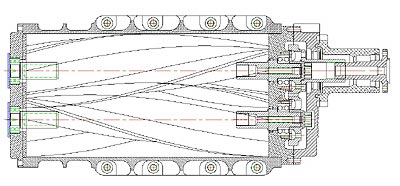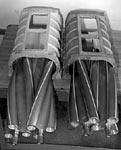|
<<
PREVIOUS PAGE
SCREW TYPE
Mechanical superchargers are either positive
displacement or not. A screw compressor is the
most efficient type of positive displacement
type supercharger available. The screw is just
as the name insinuates the rotors appear to
screw into each other. A screw compressor has
a male and female rotor where only one rotor
displaces air. Because of this, the rpm at which
these units run is greater than a roots design.
The internal tolerances of the screw compressor
are very tight, and the inter-twined rotors
act as a seal against any leakage up through
the rotors. The screw has an inlet cavity that
decreases in size as the rotors rotate. This
compresses the air charge internally, because
of this it can be called an air compressor.
The screw is known to be a very powerful supercharger
design, while the rotors are large and can be
heavy it is commonly over 200 horsepower over
a roots supercharger. The reason for this power
difference is the combination of lower discharge
temperatures and lower parasitic drag because
of no rubbing internal parts.
ROOTS SUPERCHARGER

The Roots supercharger is the old tried and
true positive displacement design used since
the GMC introduction on diesel trucks and even
earlier in coal mines to move valuable air to
the soon to be cancer victims at the bottom
of the mine.
 The
Hi-Helix (left) and Standard Helix superchargers. The
Hi-Helix (left) and Standard Helix superchargers.
The Roots has two rotors with three lobes per
rotor. The Roots supercharger has two rotor
types, the Hi-Helix and the Standard Helix.
The high helix rotors are called 120-degree
rotors and the standard rotors are called 60
degree. This is the amount of rotor twist over
the length. Both rotors in the Roots design
displace air, giving the roots a large displacement
per rotation.
The size of the supercharger is based from
the rotor length. A 6-71 supercharger has a
15-inch long rotor, and an 8-71 has a 16-inch
one. This keeps going until the 16-71, which
has a 20-inch long rotor.
 This
is Kobelco's 14-71 supercharger. This
is Kobelco's 14-71 supercharger.
Roots superchargers use Teflon sealing strips
to help seal small clearances between the rotors
and also to seal rotor to bore. These Teflon
strips need replacing from time to time to keep
the blower to its peak efficiency.
CENTRIFUGAL SUPERCHARGERS
Centrifugal superchargers are belt-driven turbine
wheels that compress air centrifugally (outward
from the center) with rpm. The impeller in the
supercharger causes air to move from the center
of the turbine and is accelerated outwards towards
the turbine housing and is then directed to
the outlet ducts. The rpm at which these superchargers
operate is very high, upwards to 30,000 plus
rpm. The centrifugal supercharger uses the same
compressor theory as a turbocharger except that
the means for driving the compressor is from
the crankshaft via belt. The supercharger has
a large gear ratio internally to bring the unit
to its needed rpm.
This type of supercharger notoriously makes
good boost pressures, but is much slower than
the positive displacement type superchargers
at building this valuable intake pressure.
NEXT
PAGE >>
|